The Air Force has in service some 200 combat-oriented remotely piloted aircraft—150 MQ-1 Predators and 46 MQ-9 Reapers. By the coming decade, USAF will have expanded that fleet to 180 Predators and 329 Reapers, for a combined 509 aircraft. What’s more, these and other RPAs will be playing a key role in virtually all of the Air Force’s core mission areas.
The service sees almost no limits for the use of these aircraft. It plans the “application of remote technology to the entire panoply” of missions, asserts Lt. Gen. David A. Deptula, Air Force deputy chief of staff for intelligence-surveillance-reconnaissance (ISR).
Their use will encompass ISR, strike, mobility—and even combat search and rescue.
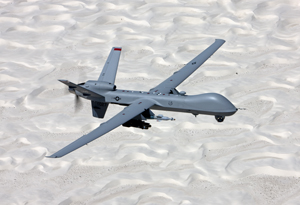 |
A Reaper performs training a mission in New Mexico. (Photos by Jim Haseltine) |
“We’ll take a look at RPA technology as it applies to every one of our 12 core function areas,” Deptula said. “We’re discussing some of those options today as we assimilate more and more of these aircraft.”
Deptula’s office is the keeper of the Air Force’s Unmanned Aircraft Systems Flight Plan, which seeks to map the acquisition of RPAs through 2047. USAF will seek constant industry input on the state of the possible technology and field commander comments on how RPAs can provide the best operational value.
Since the Flight Plan was published in mid-2009, the Air Force has dropped the term “unmanned aircraft systems” because “there’s nothing unmanned about them,” Deptula said. It can take as many as 170 persons to launch, fly, and maintain such an aircraft as well as to process and disseminate its ISR products.
The UAS term gave the false impression that they required little manpower investment, Deptula noted.
Col. Dale Fridley, director of USAF’s RPA Task Force, says today’s Predators and Reapers can collect ISR and attack targets with missiles and (in the case of the Reaper) bombs. He says the Air Force’s planned fleet of RPAs will be substantial, in light of its goal of maintaining no more than 2,000 fighters. In addition, the service will eventually deploy 77 RQ-4 Global Hawk high-altitude RPAs, which are ISR-only platforms.
Early in the next decade, the Air Force will deploy a new, stealthy RPA—currently called the MQ-X—capable of surviving in heavily defended airspace and performing a wide variety of ISR and strike missions. It will complement a new long-range ISR-strike platform—previously known as a bomber—which may be “optionally manned.”
Beyond that, the use of RPAs will depend on how autonomous the technology of the time can make them and how willingly humans will allow the machines to make lethal decisions on their own.
The Reaper, with a 66-foot wingspan and a weapons load that rivals that of the F-16 fighter, evolved from the Predator, but won’t displace it from the force in the near future.
Fridley said the original plan was to phase out the Predator as the Reaper came into the inventory, but at the direction of Defense Secretary Robert M. Gates, the Air Force is building RPA capability as fast as possible to provide ISR support to forces fighting in Iraq and Afghanistan. Predators are being retained even as the more powerful Reapers are delivered and fielded.
The Reaper more than doubles the Predator’s range and speed, while carrying almost 10 times the payload, and USAF has decided to focus on the Reaper because of its greater capability. Although the Air Force and Army were working on a common RPA a few years ago, the Air Force asked to be excused from the program because the smaller aircraft had too many limitations, Deptula said.
The Reaper, for example, can be fitted with a pod set called Gorgon Stare, which multiplies by 10—and in the future, by 30—the number of discrete video feeds one Reaper can broadcast to coalition forces.
The Air Force is also working on Vortex, a pod set that will give the Reaper a broadly expanded capability to detect and track moving targets on the ground. Other pods will collect signals and other forms of intelligence. The Predator cannot carry such payloads.
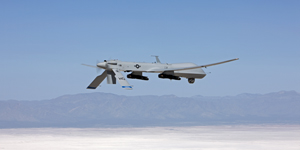 |
|
While the Air Force worked “very, very hard” to partner with the Army on what became the MQ-1C Warrior, a variant of Predator, “if I can provide a tenfold increase in what the warfighter wants, … why would I want to buy a lesser platform? That’s why the Air Force is moving to the MQ-9,” Deptula asserted.
The Army uses its Warriors differently from the way the Air Force uses Predators and Reapers. While the Air Force provides RPA coverage for all the services, the Army’s RPAs belong to specific Army divisions, and work directly for them when they are deployed. When not deployed, they are idled or are used for training. USAF’s Predators and Reapers remain forward-based nearly all the time.
Developing the Nomenclature
For several years, the Air Force sought to become the executive agent among the services for RPA technology, asserting that it could best coordinate their use in busy combat airspace and deconflict them from other RPAs as well as manned aircraft. Former Deputy Defense Secretary Gordon R. England opted not to grant USAF that authority.
“It became an emotional issue,” Deptula said, which clouded the Air Force’s intent: “to come up [with] a forum in which a variety of issues that faced all our services could be discussed. … Right now, that’s not going anywhere.”
However, there are four main interservice RPA issues yet to be resolved, he said. Those are: joint concepts of operation, airspace control, air defense, and streamlined acquisition. In the absence of an executive agent, the services are working to address those issues “with one another and on their own.”
The Air Force measures its RPA presence in-theater with the term “CAP,” which equals a 24-hour presence over a given geographical area. A single combat air patrol translates to about four aircraft: three in-theater and one at home base for training.
By the end of Fiscal 2011, USAF plans to have 50 CAPs orbiting over Iraq and Afghanistan; by 2013, it will maintain 65 CAPs.
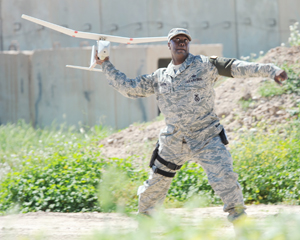 |
MSgt. Bryon Griffin launches an RQ-11B Raven at Kirkuk AB, Iraq. The RPA can look over hills and other obstructions. (USAF photo by SSgt. Tabitha Kuykendall) |
However, Deptula said he’s unhappy with the terminology. A Reaper fitted with Gorgon Stare pods can scan a much larger area—a whole city versus one block—and can pass 10 discrete video feeds to separate users, versus a Reaper without the pods. Yet both count as one CAP.
Deptula said USAF is exploring new nomenclature that would more accurately describe the output without linking it to a particular platform—say, a Predator CAP or Reaper CAP.
“We’re looking at a terminology along the lines of: remote air mission, remote ground mission, remote sea mission,” to encompass not only remotely flown aircraft, but also remotely operated ground vehicles and naval vessels.
In the case of a remote air mission—RAM—the number of video feeds could be specified with a V.
With a Gorgon Stare-equipped Reaper, “the V is 10 video images, so you might have a RAM V-10,” Deptula explained. “Obviously, there’s a big difference between a RAM V-10 and a RAM V-1.” Then, he said, “you could get even more discriminating by adding prefixes and suffixes” to describe other capabilities onboard, such as electronic attack or Sigint.
Whatever nomenclature is adopted, he said, it should be platform-agnostic and “generic … so it’s not limited to just one service or component.” The new lexicon would make it easier for theater commanders to understand just what options they have, Deptula observed. Changing the terminology will add precision to requests for imagery, which today usually come in the form of a call for simply “a Predator.”
The Air Force plans to field one MQ-9 CAP with Gorgon Stare this fall. It will be able to produce and transmit up to 10 separate full-motion video feeds—called “chip-outs”—from several wide-area cameras via a line-of-sight data link. For users who are not within line of sight, the data can be recorded onboard and downloaded later. That approach will save on bandwidth, the chief limitation on RPAs.
The Gorgon Stare Increment Two will add improved electro-optical and imaging infrared, greater area coverage, improved resolution, and greater storage capacity. It will be available by the middle of Fiscal 2012, and there will be enough two-pod sets for another two Reaper CAPs. Expected advances in data compression will make possible 30 or more real-time video feeds from each Increment Two pod set. All told, 10 sets of Gorgon Stare pods are planned.
The Reaper can carry Hellfire missiles and laser guided bombs, and will be fitted with both the Small Diameter Bomb and the Joint Direct Attack Munition, or JDAM. It’s also likely that a new low-collateral damage bomb now starting development will be certified for the Reaper.
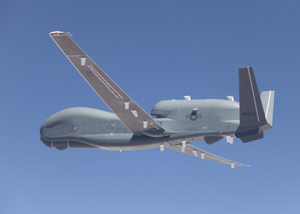 |
The RQ-4A Global Hawk Battlefield Airborne Communications Node (BACN) made its first flight on July 14. The aircraft flew from Palmdale, Calif., to Edwards AFB, Calif. (USAF photo by Greg L. Davis) |
However, USAF is not planning to try to adapt the MQ-9 for air-to-air combat—although it can carry AIM-9 Sidewinder air-to-air missiles—or fit it with chaff or flares to evade surface-to-air missiles.
The self-defense mechanism for RPAs, Fridley said, will be “for the Air Force to … own the airspace that the MQ-9 and MQ-1 are going to operate in.” The service has never claimed that the Reaper can fly in bad weather or in contested airspace. Those are two limitations that USAF hopes to overcome with the MQ-X.
The MQ-X, Deptula said, “is not a follow-on [for] the MQ-9” in the way that the Reaper was a larger, faster evolution of the Predator.
Rather, “we’re looking … to apply remote piloted technology to the spectrum of Air Force core functions, and come up with an aircraft that can fulfill … or can assist in [as] many of those core functions as we possibly can.”
In April, the Air Force abandoned a previous set of studies and analyses related to MQ-X, having decided that the scope of the project was too narrow and failed to give enough weight to modularity and flexibility for other missions. More “stakeholders” will be involved in setting new requirements for the system.
No “Son of MQ-9”
The first main attribute for MQ-X will be modularity, Deptula said, such that the aircraft can be rapidly reconfigured to fulfill any of a number of widely divergent missions; “much, much different than anything we’ve seen before.”
Industry sources said such aircraft might have reconfigurable wings and bodies for high-speed dashes or fuel-sipping loiter missions, while being nearly invisible over enemy terrain.
Survivability—which is not synonymous with stealth—is the second major attribute the MQ-X will have, Deptula noted.
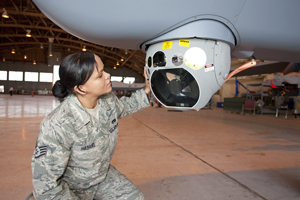 |
SSgt. Stephanie Hagans inspects the “eye” of a Reaper, the MTS-B Multispectral Targeting System. Plans call for Reaper to supply 10, and then 30, video feeds. (Photo by Jim Haseltine) |
“We have plenty of MQ-[1]s and MQ-9s right now” that can operate in permissive airspace, he said, but in contested airspace, “those aircraft are extremely vulnerable.”
The third major attribute of the MQ-X will be autonomy, since it is likely that an enemy will seek to cut the links between the operator and the aircraft. Today, RPAs know when they are out of touch with their operators, and if that happens, some can return safely to base. With the MQ-X, the Air Force wants an aircraft that can continue the mission on its own, if control links are cut.
Fridley said the “earliest” MQ-9s will need to be replaced is in the 2020-22 time frame, and that’s the target period for introducing the MQ-X. Air Combat Command will have the lead in setting the requirements, but the ISR community will have the opportunity to “shape” that requirement, he said.
Deptula said the Reaper still represents the infancy of RPAs, akin to the sophistication of aircraft in World War I. With the MQ-X, the Air Force will seek a quantum jump in capability like the advance from biplanes to the jet age, he said.
The Navy is developing a carrier-based, stealthy, fighter-sized RPA that will have about the same payload capacity as the F-35 fighter. It may be derived from the X-47, under the Navy’s Unmanned Combat Air System, or UCAS. The program descends from a joint Air Force-Navy effort, but USAF withdrew several years ago, as it focused on the next generation ISR-strike program.
Deptula said the UCAS is not what the Air Force is after with MQ-X.
“What we’re talking about … is a very different design. Something that we haven’t really conceived yet.” He added, “This is not just ‘Son of MQ-9.’ “
Deptula said one of the “modular” capabilities of the MQ-X might be as an electronic attack-electronic warfare platform. Conceivably, it might also escort the F-22 and F-35, although “right now we’re not envisioning MQ-X to have supercruise capability.”
How it will differ from what used to be called the next generation bomber is that the long-range ISR-strike platform will “have a lot more range and payload capability than the MQ-X.”
He said he expected the long-range ISR-strike aircraft to need more stealth than MQ-X, but that there are other ways to obtain survivability.
With large numbers of systems, for example, “you can afford to lose some, but the mission can still succeed.”
While the Reaper will typically operate in the 15,000 to 30,000-foot regime, the Global Hawk can fly up to 65,000 feet, and remain on station for 35 hours.
The Global Hawk is being adapted to missions beyond ISR. The Block 20 version, for example, will be used as a communications relay platform, to provide better communications for troops in Afghanistan surrounded by high mountains, which hamper line-of-sight transmissions.
The Air Force plans to acquire 77 Global Hawks, of four different blocks with increasing levels of capability. While the Block 10s are used mostly for optical and radar imagery, the Block 20s are earmarked as Battlefield Airborne Communications Node, or BACN, platforms, Fridley explained. The Block 30s, now being delivered, have more sensitive ISR sensors, and the Block 40s will add more signals, imaging, and measurement intelligence capability, “and even some GMTI,” or ground moving target indicator intelligence, Fridley said.
“Obviously, with each block we get more capability,” he observed.
The Navy is pursuing a highly similar aircraft and plans to buy about 60 RQ-4s under the Broad Area Maritime Surveillance program. The Air Force and Navy recently signed an agreement to seek common training and support functions for the Global Hawk and BAMS, toward reducing manpower and lowering costs.
Although it experimented with using its own version of the Reaper, the Navy decided the type didn’t mesh well with its concept of operations and was too difficult to support. It transferred its unwanted Reapers to the Air Force, which, after some modifications, will use them as training airplanes.
As the Air Force employs them, RPAs deployed forward have a skeleton crew to set them up, calibrate their systems, and get them ready for takeoff and landing. This is called a launch and recovery element, or LRE. However, after the aircraft get airborne, and up to just before they land, they are “flown” by operators back in the US, at what is called the mission control element, typically a two-man team of pilot and sensor operator. This arrangement is called “remote split operations.”
Key Is Modularity
Because the forward footprint is so small, Deptula said he doesn’t foresee a time when Pacific Air Forces or US Air Forces in Europe, for example, will need their own organic RPA capabilities.
“There are huge advantages that outweigh any disadvantages by operating the systems in a remote split-ops CONOPS,” Deptula asserted. “They are under the control of whomever they are assigned to. Don’t get … the method of operation confused with the allocation of the asset.”
Even after the wars in Iraq and Afghanistan wind down, the need to keep operations costs low will still weigh in favor of basing RPAs in the continental US and redeploying them as needed to theater commanders, he said.
The “beauty” of RPAs is that they can be used “wherever they’re needed, around the world, all the time. … Under an organic concept, the only systems that are used are with the units that are deployed.”
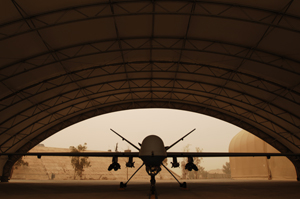 |
An MQ-9 Reaper takes shelter during a sandstorm at JB Balad, Iraq. A Reaper fitted with Gorgon Stare can pass 10 discrete video feeds to separate users. (USAF photo by A1C Jason Epley) |
The real manpower requirement for RPAs is in the analysis of their video products, Deptula said. Since the numbers of RPAs are increasing—but the number of USAF personnel available to process, exploit, and disseminate their products are fixed—the service is seeking ways to automate the way the data are analyzed.
“The things that we’re working very hard on is automating a lot of what analysts do individually. And so, instead of having a person [watch] a video screen looking for a person to come out of a building, I can come up with the technology that does that automatically … [and] tracks that person and provides notification” to an analyst that the person of interest has moved.
“You can imagine how much time that saves,” Deptula said, adding that such technologies are near-term.
Beyond the Global Hawk, Deptula said, the Air Force sees promise in lighter-than-air aircraft, “where you can make some enormous apertures that will allow us to greatly increase our take” in the GMTI and airborne moving target intelligence arenas. Those prospects have to be better explored “before we make any decisions about what we buy in the future.”
The UAS Flight Plan does not limit itself to items in the Predator-Reaper or Global Hawk classes. At the low end of the spectrum, the Air Force is busy developing “nano-micro” systems, of the size of a small bird or insect, that will be able to penetrate rooms to conduct reconnaissance, cyber attack, or even lethal operations. The service already fields a number of hand-launched “man-portable” systems such as the Raven, which can look over hills and resembles toy radio-controlled aircraft, and is investigating air-launched systems that may or may not be expendable.
At the high end, the roadmap talks about “tanker-sized” RPAs that could perform long, dull jobs such as serving as communications nodes while simultaneously providing air refueling and GMTI missions with onboard radars. The keys, Deptula said, are in modularity, and the fact that “we aren’t ever going to use a single aircraft for a single mission” ever again.
However, Deptula does not think that military pilots are a profession on the edge of extinction.
He doesn’t expect that, even with onboard computer processors rated equivalent to the human brain, an air-to-air fighter could be remotely piloted. So far, technology does not allow the “360-degree spherical situational awareness” necessary for a pilot to sense a rapidly changing situation and take the appropriate action in a split-second battle.
Moreover, “linkages are vulnerable,” and for the near term, RPAs can’t be trusted yet to wield lethal power without the overwatch of a human.
Especially as it involves nuclear weapons, “I don’t know that we want to relegate the decision authority … to an automated device. I don’t think we’re that close.”
